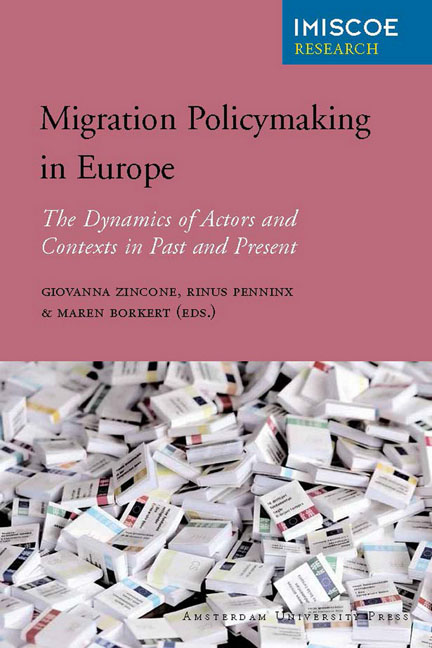Book contents
- Frontmatter
- Contents
- Policymaking in the Field of Migration and Integration in Europe: An Introduction
- Part I Post-War Migration Countries
- Part II Mediterranean Migration Countries
- Part III Eastern European Countries
- Conclusion: Comparing the Making of Migration Policies
- List of Contributors
- Other IMISCOE Titles
6 - The Case of the United Kingdom
Published online by Cambridge University Press: 20 January 2021
- Frontmatter
- Contents
- Policymaking in the Field of Migration and Integration in Europe: An Introduction
- Part I Post-War Migration Countries
- Part II Mediterranean Migration Countries
- Part III Eastern European Countries
- Conclusion: Comparing the Making of Migration Policies
- List of Contributors
- Other IMISCOE Titles
Summary
Immigration to the United Kingdom since World War II
Immigration and integration policymaking in the United Kingdom have undergone a number of significant changes and paradigm shifts over the past decades. Naturally, policies have been affected by broader economic and social developments, such as the impact of globalisation on industries as well as labour demand for particular skills, and economic cycles, e.g. accelerating economic growth and increasing employment rates, followed by a decline with 2008's economic crisis. In addition, party politics and external events have impacted policies, such as changes in government from Conservative in the 1970s and the 1980s to Labour in the 1990s, the terrorist attacks of 9/11 in the United States and the 7 July 2005 bombings in London.
What distinguishes the history of British immigration politics from other cases is first and foremost the long-lasting attempt to regulate and reduce the immigration not of ‘aliens’ or ‘foreigners’, but of people from the Empire, whose population of about 800 million had for all intents and purposes been made British nationals. Yet, both the composition and the origin of migration to the UK have visibly changed over the past few decades. The 1948 Nationality Act was the last moment at which a liberal settlement was open to the Empire. The act, which created a legal status – Citizenship of the UK and Colonies – included Britons and colonial British subjects under a single definition of British citizenship and established their right to enter the UK (Hansen 1999: 65). The act thus also tried to assert Britain's role as leader of the Commonwealth (Somerville, Sriskandarajah & Latorre 2009).
A liberal immigration policy allowed unrestricted access from the colonies and the Commonwealth until 1962. At the time, the immigration of non-British subjects was already controlled, even though the government recruited ‘aliens’ to fill labour shortages through schemes such as the European Volunteer Workers (EVW) Programme. Since the UK was losing large numbers of its own citizens to North America, Australia and other Commonwealth countries, the government also encouraged different types of immigration. This situation paved the way for immigration first from Ireland in the 1940s and 1950s and, later, the English-speaking Caribbean and the Indian subcontinent (Layton-Henry 2004).
- Type
- Chapter
- Information
- Migration Policymaking in EuropeThe Dynamics of Actors and Contexts in Past and Present, pp. 195 - 244Publisher: Amsterdam University PressPrint publication year: 2012



